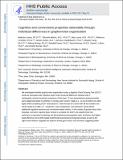Cognitive and connectome properties detectable through individual differences in graphomotor organization
Author(s)
Lamar, Melissa; Ajilore, Olusola; Leow, Alex; Charlton, Rebecca; Cohen, Jamie; GadElkarim, Johnson; Yang, Shaolin; Zhang, Aifeng; Davis, Randall; Penney, Dana; Libon, David J.; Kumar, Anand; ... Show more Show less
DownloadDavis_Cognitive and connectome.pdf (838.1Kb)
PUBLISHER_CC
Publisher with Creative Commons License
Creative Commons Attribution
Terms of use
Metadata
Show full item recordAbstract
We investigated whether graphomotor organization during a digitized Clock Drawing Test (dCDT) would be associated with cognitive and/or brain structural differences detected with a tractography-derived structural connectome of the brain. 72 non-demented/non-depressed adults were categorized based on whether or not they used 'anchor' digits (i.e., 12, 3, 6, 9) before any other digits while completing dCDT instructions to "draw the face of a clock with all the numbers and set the hands to 10 after 11". 'Anchorers' were compared to 'non-anchorers' across dCDT, additional cognitive measures and connectome-based metrics. In the context of grossly intact clock drawings, anchorers required fewer strokes to complete the dCDT and outperformed non-anchorers on executive functioning and learning/memory/recognition tasks. Anchorers had higher local efficiency for the left medial orbitofrontal and transver se temporal cortices as well as the right rostral anterior cingulate and superior frontal gyrus versus non-anchorers suggesting better regional integration within local networks involving these regions; select aspects of which correlated with cognition. Results also revealed that anchorers' exhibited a higher degree of modular integration among heteromodal regions of the ventral visual processing stream versus non-anchorers. Thus, an easily observable graphomotor distinction was associated with 1) better performance in specific cognitive domains, 2) higher local efficiency suggesting better regional integration, and 3) more sophisticated modular integration involving the ventral ('what') visuospatial processing stream. Taken together, these results enhance our knowledge of the brain-behavior relationships underlying unprompted graphomotor organization during dCDT.
Date issued
2016-03Department
Massachusetts Institute of Technology. Computer Science and Artificial Intelligence LaboratoryJournal
Neuropsychologia
Publisher
Elsevier
Citation
Lamar, Melissa et al. “Cognitive and Connectome Properties Detectable through Individual Differences in Graphomotor Organization.” Neuropsychologia 85 (May 2016): 301–309 © 2016 Elsevier
Version: Author's final manuscript
ISSN
0028-3932